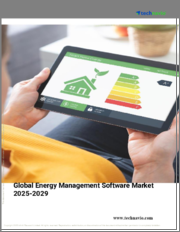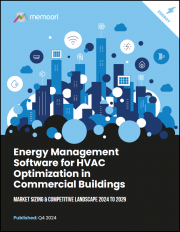
|
시장보고서
상품코드
1700101
세계의 지속 가능성 에너지 관리 소프트웨어 시장 예측(-2032년) : 컴포넌트별, 전개 형태별, 조직 규모별, 모듈별, 최종 사용자별, 지역별 분석Sustainability Energy Management Software Market Forecasts to 2032 - Global Analysis by Component (Software and Services), Deployment Mode, Organization Size, Module, End User and By Geography |
||||||
Stratistics MRC에 따르면 지속 가능성 에너지 관리 소프트웨어 세계 시장은 2025년에 19억 달러를 차지할 전망이며 예측 기간 동안 CAGR 13.8%로 성장하여 2032년에는 47억 달러에 이를 것으로 예상됩니다.
지속 가능성 에너지 관리 소프트웨어는 기업이 환경에 미치는 영향을 줄이면서 에너지 소비를 모니터링, 분석 및 최적화할 수 있는 디지털 솔루션으로, 기업이 이산화탄소 배출량을 추적하고, 에너지 효율을 개선하고, 지속 가능성 규제를 준수하는 데 도움이 됩니다. 분석, AI를 활용한 인사이트, 실시간 모니터링을 갖춘 이 소프트웨어는 에너지 비용 절감과 지속 가능성 목표 달성을 위한 데이터 주도 전략을 제공하고 있습니다.
지속 가능성과 이산화탄소 감축에 대한 관심 증가
지속 가능성과 이산화탄소 감축에 중점을 두고 시장의 획기적인 성장을 가속하고 있습니다. 실시간 모니터링, AI 주도 인사이트, 첨단 분석 기능은 생산성을 높여 기업이 지속 가능성의 목표를 성공적으로 달성하는데 도움이 됩니다.
높은 초기 투자 및 도입 비용
초기 투자와 도입 비용이 높은 것은 지속 가능성 에너지 관리 소프트웨어 시장의 큰 장벽이 되고 있습니다. 또한 에너지 효율적인 업무로의 전환을 늦추고 있으며, 통합의 복잡성과 교육 비용이 채용을 더욱 저해하고 시장 성장을 제한하며 지속 가능성 주도 에너지 관리 솔루션의 전반적인 영향력을 저하시키고 있습니다.
AI와 IoT 통합의 발전
AI와 IoT 통합의 진보는 효율성, 정확성, 실시간 의사결정을 강화함으로써 지속 가능성 에너지 관리 소프트웨어 시장에 혁명을 일으키고 있습니다. 이러한 혁신은 기업의 비용 절감, 규제 준수 및 지속 가능성 목표를 추진합니다. 보다 스마트한 그리드 관리를 가능하게 함으로써 AI와 IoT는 이산화탄소 배출량을 최소화하고 재생 가능 에너지의 도입을 가속화하여 장기적인 에너지 지속 가능성을 달성할 수 있는 힘을 조직합니다.
데이터 보안 및 개인 정보 보호 문제
데이터 보안 및 프라이버시 우려는 사이버 위협, 규제 준수 및 데이터 유출을 경계하는 기업의 채용을 제한하고 지속 가능성 에너지 관리 소프트웨어 시장의 방해가 되고 있습니다. 기업은 이러한 위험에 직면하여 클라우드 기반 솔루션의 완벽한 통합에 소극적입니다.
COVID-19의 영향
COVID-19의 대유행은 지속 가능성과 에너지관리 소프트웨어의 중요성을 돋보이게 했습니다. 이산화탄소 배출량을 줄이고 업무 효율을 높이기 위해 이러한 툴을 채용하는 경향이 강해졌습니다.
예측 기간 동안 소프트웨어 부문이 최대가 될 전망
첨단 소프트웨어 솔루션이 에너지 소비를 최적화하고 이산화탄소 배출량을 줄이고 기업의 업무 효율성을 높이기 때문에 소프트웨어 부문은 예측 기간 동안 최대 시장 점유율을 차지할 것으로 예상됩니다. 이를 통해 의사 결정을 개선하고 환경 규제 준수를 보장합니다. 재생 가능 에너지원과 수요 측 관리를 통합함으로써 소프트웨어는 에너지 절약 노력을 강화하고 지속 가능성 목표의 중요한 인에이블러가 되어 친환경 미래에 대한 촉매가 됩니다.
예측 기간 동안 의료 부문의 CAGR이 가장 높을 것으로 예상
병원과 의료 시설이 24시간 365일 가동하고 방대한 에너지를 소비하기 때문에 지속 가능성에 대한 대처가 필수적이므로 예측 기간 중 의료분야가 가장 높은 성장률을 나타낼 것으로 예측됩니다. 에너지 관리 소프트웨어를 도입하여 소비량을 모니터링하고, 업무 효율을 높이며, 재생 가능 에너지원을 통합하고 있습니다.
최대 점유율을 차지하는 지역
예측 기간 동안 북미가 가장 큰 시장 점유율을 차지할 것으로 예상됩니다., 비용 절감, 재생 가능 에너지의 통합을 촉진하고 보다 친환경 경제를 촉진합니다.
CAGR이 가장 높은 지역
예측 기간 동안 정부의 규제 강화, 기업의 지속 가능성 목표, 에너지 비용 상승으로 아시아태평양이 가장 높은 CAGR을 나타낼 것으로 예측됩니다., ESG 목표를 달성하기 위해 이러한 솔루션을 채택하고 있습니다. AI와 IoT의 진보로 실시간 모니터링과 예측 분석이 의사 결정을 개선하고 있습니다.
사용자 정의 무료 제공
이 보고서를 구독하는 고객에게는 다음 무료 맞춤 옵션 중 하나가 제공됩니다.
- 기업 프로파일
- 추가 시장 진출기업의 종합적 프로파일링(최대 3개사)
- 주요 기업의 SWOT 분석(최대 3개사)
- 지역 세분화
- 고객의 관심에 맞춘 주요국 시장 추정 및 예측과 CAGR(주 : 실현 가능성에 따름)
- 경쟁 벤치마킹
- 제품 포트폴리오, 지리적 존재, 전략적 제휴를 통한 주요 기업 벤치마킹
목차
제1장 주요 요약
제2장 서문
- 개요
- 이해관계자
- 조사 범위
- 조사 방법
- 데이터 마이닝
- 데이터 분석
- 데이터 검증
- 조사 접근
- 조사 자료
- 1차 조사 자료
- 1차 조사 자료
- 전제조건
제3장 시장 동향 분석
- 소개
- 성장 촉진요인
- 억제요인
- 기회
- 위협
- 최종 사용자 분석
- 신흥 시장
- COVID-19의 영향
제4장 Porter's Five Forces 분석
- 공급자의 협상력
- 구매자의 협상력
- 대체품의 위협
- 신규 참가업체의 위협
- 경쟁 기업간 경쟁 관계
제5장 세계의 지속 가능 에너지 관리 소프트웨어 시장 : 컴포넌트별
- 소개
- 소프트웨어
- 서비스
- 컨설팅
- 구현 및 통합
제6장 세계의 지속 가능 에너지 관리 소프트웨어 시장 : 전개 형태별
- 소개
- 온프레미스
- 클라우드 기반
제7장 세계의 지속 가능 에너지 관리 소프트웨어 시장 : 조직 규모별
- 소개
- 대기업
- 중소기업
제8장 세계의 지속 가능 에너지 관리 소프트웨어 시장 : 모듈별
- 소개
- 유틸리티 데이터 관리
- 탄소 보고 및 관리
- 지속 가능 경영 보고 및 관리
- 에너지 최적화
- 시설 및 자산 관리
- 컴플라이언스 관리
제9장 세계의 지속 가능 에너지 관리 소프트웨어 시장 : 최종 사용자별
- 소개
- 제조업
- 에너지 유틸리티
- 상업 빌딩과 주택 빌딩
- 의료
- IT 및 통신
- 소매
- 정부 및 공공 부문
- 운송 및 물류
- 기타
제10장 세계의 지속 가능 에너지 관리 소프트웨어 시장 : 지역별
- 소개
- 북미
- 미국
- 캐나다
- 멕시코
- 유럽
- 독일
- 영국
- 이탈리아
- 프랑스
- 스페인
- 기타 유럽
- 아시아태평양
- 일본
- 중국
- 인도
- 호주
- 뉴질랜드
- 한국
- 기타 아시아태평양
- 남미
- 아르헨티나
- 브라질
- 칠레
- 기타 남미
- 중동 및 아프리카
- 사우디아라비아
- 아랍에미리트(UAE)
- 카타르
- 남아프리카
- 기타 중동 및 아프리카
제11장 주요 개발
- 계약, 파트너십, 협업, 합작투자
- 인수와 합병
- 신제품 발매
- 사업 확대
- 기타 주요 전략
제12장 기업 프로파일링
- ABB
- Accruent
- Accuvio
- Brightly
- CA Technologies
- Ecova
- Enablon
- Envizi
- Figbytes
- Gensuite
- IBM
- ICONICS
- MRI Software LLC
- Planon
- SAP
- Schneider Electric
- Thinkstep
- Urjanet
- Verisae
- WatchWire
According to Stratistics MRC, the Global Sustainability Energy Management Software Market is accounted for $1.9 billion in 2025 and is expected to reach $4.7 billion by 2032 growing at a CAGR of 13.8% during the forecast period. Sustainability energy management software is a digital solution that enables organizations to monitor, analyze, and optimize their energy consumption while reducing environmental impact. It helps businesses track carbon emissions, improve energy efficiency, and comply with sustainability regulations. Equipped with advanced analytics, AI-driven insights, and real-time monitoring, the software provides data-driven strategies for reducing energy costs and achieving sustainability goals. Industries across manufacturing, commercial buildings, utilities, and transportation leverage these platforms to enhance operational efficiency.
Market Dynamics:
Driver:
Growing Focus on Sustainability & Carbon Reduction
The increased emphasis on sustainability and carbon reduction is driving considerable market growth. These technologies are being used by businesses more and more to monitor, evaluate, and optimize energy use while lowering carbon footprints. Demand is further fueled by strict government rules, business ESG objectives, and growing energy costs. Real-time monitoring, AI-driven insights, and advanced analytics boost productivity and help businesses successfully fulfill sustainability goals. The market for energy management software is expected to grow quickly as businesses place a higher priority on environmentally friendly operations.
Restraint:
High Initial Investment & Implementation Costs
High initial investment and implementation costs pose a significant barrier to the sustainability energy management software market. Many businesses, particularly small and medium enterprises, struggle to justify the upfront expenses, delaying adoption. These costs hinder widespread deployment, slowing the transition to energy-efficient operations. Additionally, integration complexities and training expenses further discourage adoption, limiting market growth and reducing the overall impact of sustainability-driven energy management solutions.
Opportunity:
Advancements in AI & IoT Integration
Advancements in AI and IoT integration are revolutionizing the sustainability energy management software market by enhancing efficiency, accuracy, and real-time decision-making. AI-driven analytics optimize energy consumption, predict maintenance needs, and reduce waste, while IoT-connected devices enable seamless monitoring and automation. These innovations drive cost savings, regulatory compliance, and sustainability goals for businesses. By enabling smarter grid management, AI and IoT empower organizations to minimize carbon footprints, accelerate renewable adoption, and achieve long-term energy sustainability.
Threat:
Data Security & Privacy Concerns
Data security and privacy concerns hinder the sustainability energy management software market by limiting adoption among enterprises wary of cyber threats, regulatory compliance, and data breaches. Organizations handling sensitive energy usage data face risks of unauthorized access, leading to reluctance in fully integrating cloud-based solutions. These concerns slow digital transformation efforts, impacting scalability, real-time monitoring, and overall efficiency in achieving sustainability goals across industries.
Covid-19 Impact:
The Covid-19 pandemic highlighted the importance of sustainability and energy management software. While global emissions briefly dropped during lockdowns, the crisis underscored the need for long-term solutions to combat climate change. Businesses increasingly adopted these tools to optimize energy use, reduce carbon footprints, and enhance operational efficiency. The pandemic accelerated awareness of sustainable practices, driving innovation and adoption in industries like manufacturing, oil and gas, and utilities.
The software segment is expected to be the largest during the forecast period
The software segment is expected to account for the largest market share during the forecast period as advanced software solutions optimize energy consumption, reduce carbon footprints, and enhance operational efficiency for businesses. AI-driven automation and cloud-based platforms improve decision-making, ensuring compliance with environmental regulations. By integrating renewable energy sources and demand-side management, software enhances energy conservation efforts, making it a key enabler of sustainability goals and a catalyst for a greener future.
The healthcare segment is expected to have the highest CAGR during the forecast period
Over the forecast period, the healthcare segment is predicted to witness the highest growth rate because hospitals and healthcare facilities operate 24/7, consuming vast amounts of energy, making sustainability initiatives essential. With regulatory pressures and cost-saving incentives, healthcare providers are adopting energy management software to monitor consumption, enhance operational efficiency, and integrate renewable energy sources. This transition not only lowers operational costs but also aligns with global sustainability goals, fostering a greener and more resilient healthcare ecosystem.
Region with largest share:
During the forecast period, the North America region is expected to hold the largest market share because businesses and governments are leveraging advanced software solutions to optimize energy usage, reduce carbon footprints, and comply with stringent sustainability regulations. This market fosters operational efficiency, cost savings, and renewable energy integration, promoting a greener economy. With increasing corporate ESG commitments and government incentives, the adoption of these solutions is accelerating, empowering organizations to achieve sustainability goals.
Region with highest CAGR:
Over the forecast period, the Asia Pacific region is anticipated to exhibit the highest CAGR due to increasing government regulations, corporate sustainability goals, and rising energy costs. This software enables businesses to optimize energy usage and enhance operational efficiency. Industries such as manufacturing, healthcare, and commercial buildings are adopting these solutions to meet ESG targets. With advancements in AI and IoT, real-time monitoring and predictive analytics are improving decision-making. This market is playing a crucial role in driving sustainability and promoting energy efficiency across the region.
Key players in the market
Some of the key players in Sustainability Energy Management Software Market include ABB, Accruent, Accuvio, Brightly, CA Technologies, Ecova, Enablon, Envizi, Figbytes, Gensuite, IBM, ICONICS, MRI Software LLC, Planon, SAP, Schneider Electric, Thinkstep, Urjanet, Verisae and WatchWire.
Key Developments:
In March 2025, ABB announced it has completed the acquisition of Siemens' Wiring Accessories business in China, to broaden ABB's market reach and complement its regional customer offering within smart buildings.
In January 2025, ABB and Skoda Group have announced a partnership. The collaboration begins with ABB supplying its innovative Traction Battery Pro Series, which is compact and lightweight, and engineered to optimize vehicle performance while significantly reducing maintenance and downtime.
In December 2024, ABB announced it has acquired Solutions Industry & Building (SIB. The acquisition of SIB strengthens ABB's presence in rail, mining, and OEM and specialty markets across Europe, the Middle East and North America.
Components Covered:
- Software
- Services
Deployment Modes Covered:
- On-Premises
- Cloud-Based
Organization Sizes Covered:
- Large Enterprises
- Small & Medium Enterprises (SMEs)
Modules Covered:
- Utility Data Management
- Carbon Reporting & Management
- Sustainability Reporting & Management
- Energy Optimization
- Facility & Asset Management
- Compliance Management
End Users Covered:
- Manufacturing
- Energy & Utilities
- Commercial & Residential Buildings
- Healthcare
- IT & Telecom
- Retail
- Government & Public Sector
- Transportation & Logistics
- Other End Users
Regions Covered:
- North America
- US
- Canada
- Mexico
- Europe
- Germany
- UK
- Italy
- France
- Spain
- Rest of Europe
- Asia Pacific
- Japan
- China
- India
- Australia
- New Zealand
- South Korea
- Rest of Asia Pacific
- South America
- Argentina
- Brazil
- Chile
- Rest of South America
- Middle East & Africa
- Saudi Arabia
- UAE
- Qatar
- South Africa
- Rest of Middle East & Africa
What our report offers:
- Market share assessments for the regional and country-level segments
- Strategic recommendations for the new entrants
- Covers Market data for the years 2024, 2025, 2026, 2028, and 2032
- Market Trends (Drivers, Constraints, Opportunities, Threats, Challenges, Investment Opportunities, and recommendations)
- Strategic recommendations in key business segments based on the market estimations
- Competitive landscaping mapping the key common trends
- Company profiling with detailed strategies, financials, and recent developments
- Supply chain trends mapping the latest technological advancements
Free Customization Offerings:
All the customers of this report will be entitled to receive one of the following free customization options:
- Company Profiling
- Comprehensive profiling of additional market players (up to 3)
- SWOT Analysis of key players (up to 3)
- Regional Segmentation
- Market estimations, Forecasts and CAGR of any prominent country as per the client's interest (Note: Depends on feasibility check)
- Competitive Benchmarking
- Benchmarking of key players based on product portfolio, geographical presence, and strategic alliances
Table of Contents
1 Executive Summary
2 Preface
- 2.1 Abstract
- 2.2 Stake Holders
- 2.3 Research Scope
- 2.4 Research Methodology
- 2.4.1 Data Mining
- 2.4.2 Data Analysis
- 2.4.3 Data Validation
- 2.4.4 Research Approach
- 2.5 Research Sources
- 2.5.1 Primary Research Sources
- 2.5.2 Secondary Research Sources
- 2.5.3 Assumptions
3 Market Trend Analysis
- 3.1 Introduction
- 3.2 Drivers
- 3.3 Restraints
- 3.4 Opportunities
- 3.5 Threats
- 3.6 End User Analysis
- 3.7 Emerging Markets
- 3.8 Impact of Covid-19
4 Porters Five Force Analysis
- 4.1 Bargaining power of suppliers
- 4.2 Bargaining power of buyers
- 4.3 Threat of substitutes
- 4.4 Threat of new entrants
- 4.5 Competitive rivalry
5 Global Sustainability Energy Management Software Market, By Component
- 5.1 Introduction
- 5.2 Software
- 5.3 Services
- 5.3.1 Consulting
- 5.3.2 Implementation & Integration
6 Global Sustainability Energy Management Software Market, By Deployment Mode
- 6.1 Introduction
- 6.2 On-Premises
- 6.3 Cloud-Based
7 Global Sustainability Energy Management Software Market, By Organization Size
- 7.1 Introduction
- 7.2 Large Enterprises
- 7.3 Small & Medium Enterprises (SMEs)
8 Global Sustainability Energy Management Software Market, By Module
- 8.1 Introduction
- 8.2 Utility Data Management
- 8.3 Carbon Reporting & Management
- 8.4 Sustainability Reporting & Management
- 8.5 Energy Optimization
- 8.6 Facility & Asset Management
- 8.7 Compliance Management
9 Global Sustainability Energy Management Software Market, By End User
- 9.1 Introduction
- 9.2 Manufacturing
- 9.3 Energy & Utilities
- 9.4 Commercial & Residential Buildings
- 9.5 Healthcare
- 9.6 IT & Telecom
- 9.7 Retail
- 9.8 Government & Public Sector
- 9.9 Transportation & Logistics
- 9.10 Other End Users
10 Global Sustainability Energy Management Software Market, By Geography
- 10.1 Introduction
- 10.2 North America
- 10.2.1 US
- 10.2.2 Canada
- 10.2.3 Mexico
- 10.3 Europe
- 10.3.1 Germany
- 10.3.2 UK
- 10.3.3 Italy
- 10.3.4 France
- 10.3.5 Spain
- 10.3.6 Rest of Europe
- 10.4 Asia Pacific
- 10.4.1 Japan
- 10.4.2 China
- 10.4.3 India
- 10.4.4 Australia
- 10.4.5 New Zealand
- 10.4.6 South Korea
- 10.4.7 Rest of Asia Pacific
- 10.5 South America
- 10.5.1 Argentina
- 10.5.2 Brazil
- 10.5.3 Chile
- 10.5.4 Rest of South America
- 10.6 Middle East & Africa
- 10.6.1 Saudi Arabia
- 10.6.2 UAE
- 10.6.3 Qatar
- 10.6.4 South Africa
- 10.6.5 Rest of Middle East & Africa
11 Key Developments
- 11.1 Agreements, Partnerships, Collaborations and Joint Ventures
- 11.2 Acquisitions & Mergers
- 11.3 New Product Launch
- 11.4 Expansions
- 11.5 Other Key Strategies
12 Company Profiling
- 12.1 ABB
- 12.2 Accruent
- 12.3 Accuvio
- 12.4 Brightly
- 12.5 CA Technologies
- 12.6 Ecova
- 12.7 Enablon
- 12.8 Envizi
- 12.9 Figbytes
- 12.10 Gensuite
- 12.11 IBM
- 12.12 ICONICS
- 12.13 MRI Software LLC
- 12.14 Planon
- 12.15 SAP
- 12.16 Schneider Electric
- 12.17 Thinkstep
- 12.18 Urjanet
- 12.19 Verisae
- 12.20 WatchWire



















